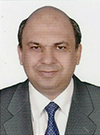COEXISTENCE OF GLANZMANN'S THROMBASTHENIA AND MAPLE SYRUP URINE DISEASE (MSUD): IMPLICATIONS FOR HEMOSTATIC MANAGEMENT.
(Abstract release date: 05/18/17)
EHA Library. Elshinawy M. 05/18/17; 182830; PB2116

Assoc. Prof. Mohamed Elshinawy
Contributions
Contributions
Abstract
Abstract: PB2116
Type: Publication Only
Background
In Oman, autosomal recessive disorders are relatively commoner than western communities due to the high prevalence of inter-tribal marriage. Unfortunately, some patients have got more than one autosomal recessive genetic disorder, owing to complex consanguinity which might further complicate proper management plans.
Aims
To report an interesting case of combined Glanzmann's thrombasthenia and MSUD, and to review the existing data of platelet function disorders in Oman.
Methods
Case report and retrospective data analysis of all cases with confirmed or suspected platelet function disorders in Pediatric Hematology Unit, Sultan Qaboos University Hospital, Muscat, Oman from January 2006 till December 2016.
Results
We report a 4 year-old girl who is a known case of MSUD. Her parents are double first cousins (from both maternal and paternal sides). At the age of 3 months, she required Gastrostomy tube (G-tube) insertion. Preoperatively, full blood count and coagulation screen were perfectly normal. Unfortunately, she developed profuse bleeding at the site of G-tube insertion, followed by massive hematemesis. The patient received multiple blood products, but bleeding didn’t stop. As an emergency measure, recombinant activated factor VII (rFVIIa) was given and resulted in cessation of bleeding. Platelet aggregation studies revealed defective aggregation with ADP, arachidonic acid, collagen and epinephrine which is consistent with Glanzmann's thrombasthenia. The diagnosis was further confirmed by platelet flow cytometry which showed no activity with CD41 and CD61, indicating absent GpIIb/IIIa complex.
The patient experienced a severe bleeding phenotype, which is further complicated by multiple coexisting factors, including the recurrent episodes of metabolic crises which provoked worsening of platelet function, the development of platelet refractoriness at the age of 1 year, and the need for recurrent invasive procedures such as G-tube and central line insertion. Currently, the bleeding episodes are managed by rFVIIa at a dose of 120-180 µg /kg/dose.
Excluding von Willebrand disease, we have 38 cases of confirmed or suspected platelet function disorders in our center, including 15 cases with Glanzmann's thrombasthenia, 7 cases with Bernard-Soulier syndrome, 5 cases with May–Hegglin anomaly and 11 cases of suspected, yet unconfirmed platelet storage pool deficiency.
Conclusion
In conclusion, children with platelet function disorders still have plenty of unmet needs, ranging from deficient accurate diagnostic facilities to the lack of agreed upon consensus management guidelines. The coexistence of another hereditary disorder may result in mutual management difficulties of both diseases. In developing countries, proper registry is needed to establish optimum care of such rare disorders.
Session topic: 32. Platelets disorders
Keyword(s): Platelet function, Glanzmann
Abstract: PB2116
Type: Publication Only
Background
In Oman, autosomal recessive disorders are relatively commoner than western communities due to the high prevalence of inter-tribal marriage. Unfortunately, some patients have got more than one autosomal recessive genetic disorder, owing to complex consanguinity which might further complicate proper management plans.
Aims
To report an interesting case of combined Glanzmann's thrombasthenia and MSUD, and to review the existing data of platelet function disorders in Oman.
Methods
Case report and retrospective data analysis of all cases with confirmed or suspected platelet function disorders in Pediatric Hematology Unit, Sultan Qaboos University Hospital, Muscat, Oman from January 2006 till December 2016.
Results
We report a 4 year-old girl who is a known case of MSUD. Her parents are double first cousins (from both maternal and paternal sides). At the age of 3 months, she required Gastrostomy tube (G-tube) insertion. Preoperatively, full blood count and coagulation screen were perfectly normal. Unfortunately, she developed profuse bleeding at the site of G-tube insertion, followed by massive hematemesis. The patient received multiple blood products, but bleeding didn’t stop. As an emergency measure, recombinant activated factor VII (rFVIIa) was given and resulted in cessation of bleeding. Platelet aggregation studies revealed defective aggregation with ADP, arachidonic acid, collagen and epinephrine which is consistent with Glanzmann's thrombasthenia. The diagnosis was further confirmed by platelet flow cytometry which showed no activity with CD41 and CD61, indicating absent GpIIb/IIIa complex.
The patient experienced a severe bleeding phenotype, which is further complicated by multiple coexisting factors, including the recurrent episodes of metabolic crises which provoked worsening of platelet function, the development of platelet refractoriness at the age of 1 year, and the need for recurrent invasive procedures such as G-tube and central line insertion. Currently, the bleeding episodes are managed by rFVIIa at a dose of 120-180 µg /kg/dose.
Excluding von Willebrand disease, we have 38 cases of confirmed or suspected platelet function disorders in our center, including 15 cases with Glanzmann's thrombasthenia, 7 cases with Bernard-Soulier syndrome, 5 cases with May–Hegglin anomaly and 11 cases of suspected, yet unconfirmed platelet storage pool deficiency.
Conclusion
In conclusion, children with platelet function disorders still have plenty of unmet needs, ranging from deficient accurate diagnostic facilities to the lack of agreed upon consensus management guidelines. The coexistence of another hereditary disorder may result in mutual management difficulties of both diseases. In developing countries, proper registry is needed to establish optimum care of such rare disorders.
Session topic: 32. Platelets disorders
Keyword(s): Platelet function, Glanzmann
{{ help_message }}
{{filter}}


